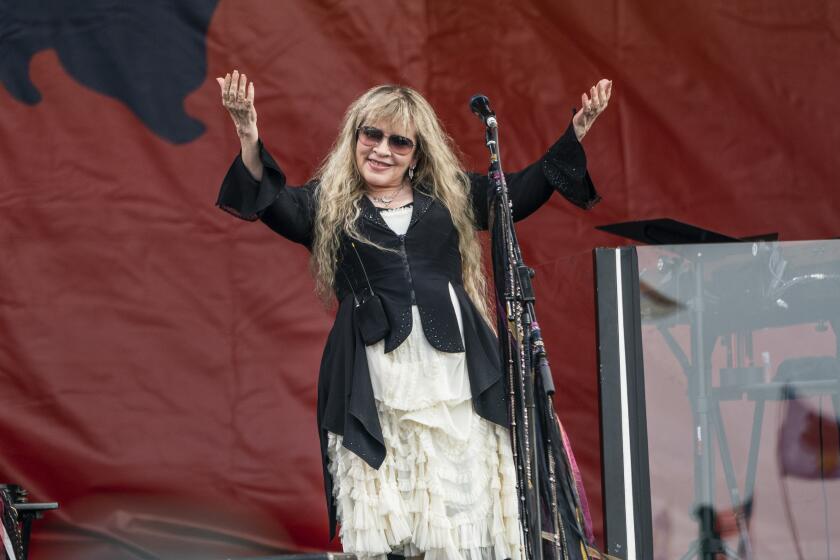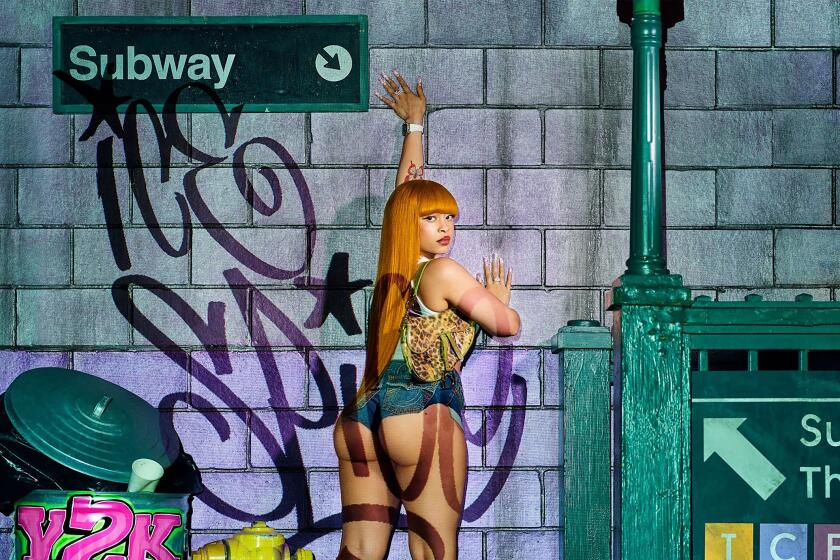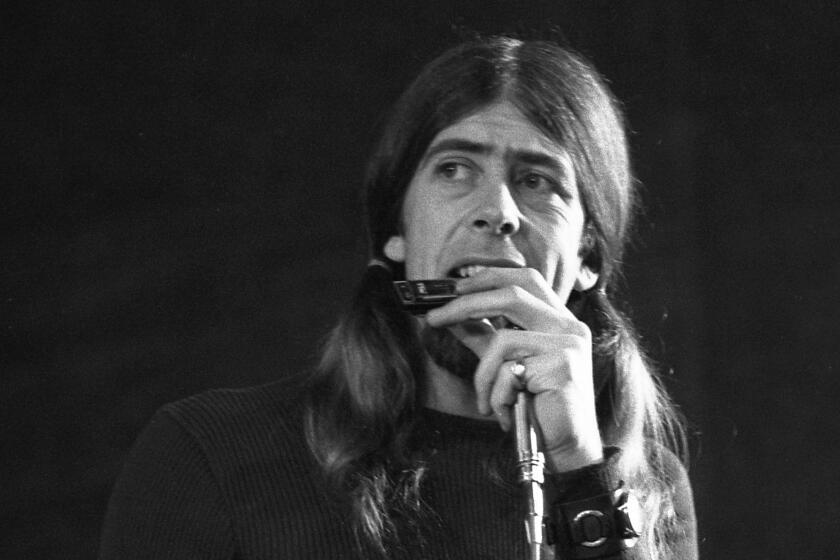Taylor Swift raises the bar with a savvy ‘Red’ marketing campaign
When Taylor Swift’s album “Red” was released last week, the pop singer’s most ardent fans wasted no time downloading the digital edition on iTunes, vaulting it to No. 1 on the online retailer’s Top Albums chart in a quick 36 minutes. Those who wanted to hold a CD with her latest 16 songs were also able to snap it up as early as 12:01 a.m. Oct. 22 at thousands of 24-hour Walgreens and Wal-Mart stores.
By daybreak though, the options had multiplied: A deluxe 22-track edition was available at Target, and if the music alone wasn’t enough, Swift aficionados could also pick up a custom pair of Keds “Red” sneakers ($49.99) or get the album along with a large pizza as part of a Papa John’s deal that featured Swift’s image on the pizza box (all for $22!).
The multi-pronged delivery of Swift’s album is part of a sophisticated marketing campaign that has contributed to the extraordinary first-week sales for “Red” of 1.21 million copies according to Nielsen SoundScan, the biggest first-week figure in more than a decade.
The success of “Red” equals hope for an industry hammered during the first decade of the digital age, one in which album sales plummeted 50%, but also raises the bar on what it takes to remain a pop star in the digital era.
Once upon a time in the record business, musicians created albums, record companies manufactured then delivered them to retail stores, took out ads in magazines, newspapers and perhaps on TV to promote them, then waited for the sales results to roll in.
Today however, generating blockbuster sales requires the right combination of hit music, star power and marketing savvy that connects with consumers wherever they might be, from discount department stores and online retailers to shoe outlets and pizza places. Swift’s album has also benefited from largely laudatory reviews, with several critics calling it the best yet in her young career (Times pop music critic Randall Roberts gave it three stars on The Times’ four-star scale).
THE ENVELOPE: The Awards Insider
The type of exclusive deals that Swift and her label Big Machine struck with various and some unlikely retailers has become a crucial part of the pop music landscape.
In 2010, Green Day licensed its music and band members’ likenesses for a “Green Day: Rock Band” edition dedicated solely to the Bay Area pop-punk band’s music. Last year, Lady Gaga partnered with social gaming giant Zynga to create a Facebook game, “Gagaville,” that helped boost awareness of her “Born This Way” album, which sold 1.1 million copies during its first week.
The last dozen years have seen the rise and dominance of individual songs over full albums. The public response to Swift’s new album epitomizes artists’ need to be ever more creative and diversified in their reach.
PHOTOS: Celebrity portraits by The Times
Not every marketing tie-in works. Last year teen pop star Justin Bieber endorsed a product called PhoneGuard designed to prevent cellphone users from texting or otherwise using phones while driving. The company lost $3.9 million in the first six months of 2012.
The increasing customization of artists’ music for different outlets means they are expected to come up with songs they can release only to certain retailers, along with other individualized content such as the photos and text for the 96-page book with Wal-Mart’s exclusive “Zinepak” edition of “Red,” also including a selection of Swift guitar picks.
Target has instituted extensive in-store promotion for “Red,” as it has for previous exclusive editions of albums from Pink, No Doubt and others.
“We have so many different tricks up our sleeve to surprise and delight guests and fans of Taylor,” Target’s vice president of entertainment John Butcher told Billboard recently.
In return, artists and their recordings receive amped-up promotion of their music, although tie-ins alone don’t automatically create mega-hits like “Red.” It’s just the 18th album to sell more than 1 million copies in a single week during the 21 years of the SoundScan era.
The plethora of different editions of a given album, however, carries a potential for backlash among fans who feel torn over which version to buy — or feel compelled to buy all the editions to get everything available from their favorite artists. So far, however, there’s been little public outcry of that sort directed toward “Red.”
With “Red,” Swift becomes only the fourth act to hit the 1 million first-week figure twice since Nielsen SoundScan began tracking actual sales back in 1991.
Not only has Swift repeated that feat despite continuing shrinkage of traditional album sales, but “Red” has topped the first-week figure of 1.05 million for its 2010 predecessor, “Speak Now,” extending her against-the-grain trend of improved first week sales with each album she has released since her 2006 debut, “Taylor Swift.”
It’s also a sign that at least some players in the beleaguered music business are finding ways to reboot in an age in which consumers have become less inclined to buy the music they listen to.
“Big Machine isn’t commenting on the marketing of the album,” a label spokesman told The Times on Monday via email. “Some of the new components with this release included Papa John’s and Walgreens, but when we see the final numbers, I think we will see record-breaking numbers from Target and iTunes, meaning most of the albums were purchased through normal sources.”
Last week, iTunes reported that first-day downloads of “Red” set a new single-day record for the digital retailer, with 262,000 copies. That’s more sales in one day than the majority of No. 1 albums have posted in full week in recent years. Target officials have indicated that they are expecting new sales highs from “Red.”
Leading up to last week’s worldwide release of “Red,” Swift kept busy on her Twitter account reminding followers — she now has more than 20 million — how many days remained until it would be available. On Oct. 21, she shifted to an hourly countdown. (Her spokeswoman insists that all tweets are sent by Swift herself and that no one else has access to her @TaylorSwift13 account.)
The day after “Red” was released she began a strategically organized blitz of national TV appearances, starting with a concert in New York City’s Times Square as part of her visit to ABC’s “Good Morning America.”
She used a “20/20” appearance to unveil plans for a 2013 “Red” concert tour of sports arenas and nine stadiums in the U.S.
The efforts weren’t restricted to TV. While the previously taped “Ellen” and “20/20” TV appearances aired Friday, Swift herself was locked down all day in Nashville giving a barrage of interviews to 72 radio stations, mostly in the U.S., and a few international outlets in regions as far-flung as South Africa, New Zealand, Spain, Germany and Mexico.
Adding to the campaign’s radio front, last week Swift messaged her Twitter followers to phone radio stations and “ask nicely BUT repetitively” to play her latest single, “Begin Again.”
The overall strategy also hasn’t simply been a matter of putting Swift and her album anywhere and everywhere possible.
Big Machine chief Scott Borchetta opted out of releasing the album to Amazon’s MP3 store out of concern the online retailing giant might do what it had done with Lady Gaga’s “Born This Way” album last year, slashing the price for the full album to 99 cents as part of a promotion (in that case, for Amazon’s new cloud music service).
That quickly pumped up sales: “Born This Way” edged past “Speak Now” and logged 1,108,000 copies, nearly half of which came from the 99-cent sale. Billboard subsequently changed its policy regarding album sales figures, and now refuses to count albums toward its national sales chart tabulations if they are sold for $3.49 or less during the first four weeks of release.
Big Machine is also bypassing streaming services including Spotify and Rhapsody in the belief that many fans who stream music as part of a monthly subscription fee are less inclined to buy CDs or album downloads.
“I don’t think it should be free,” Borchetta said at a music business conference in Las Vegas last month. “I don’t have thousands and thousands of albums and hundreds and hundreds of artists, I have a finite artist roster and finite number of releases. If you’re a big battleship like Sony or Universal and have tens of thousands of masters, that income stream makes sense at a big corporation. It doesn’t make sense to a small record company.”
PHOTOS AND MORE:
PHOTOS: Iconic rock guitars and their owners
The Envelope: Awards Insider
PHOTOS: Unfortunately timed pop meltdowns
More to Read
The biggest entertainment stories
Get our big stories about Hollywood, film, television, music, arts, culture and more right in your inbox as soon as they publish.
You may occasionally receive promotional content from the Los Angeles Times.






